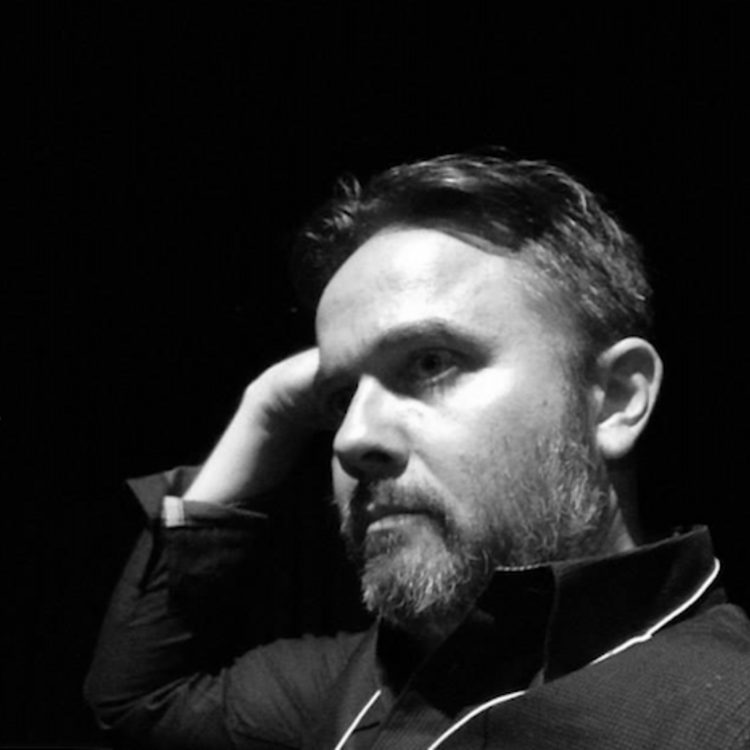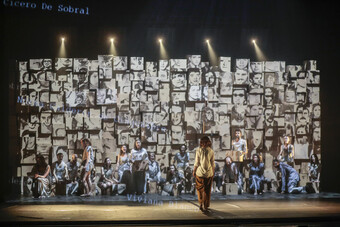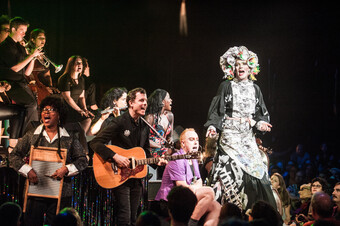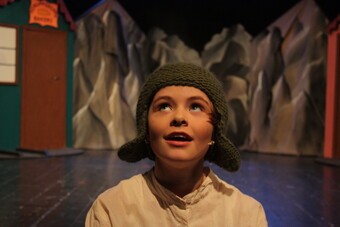The Sonic Harvests of Øystein Elle / Capto Musicae
“I am generally not very interested in creating meaning,” says Øystein Elle, reflecting upon his growing body of work. “Perhaps I don’t understand the concept of it. I am attracted to so-called nonsense because it often appears to me as more real than sense.”
For the past four years, the Norwegian vocalist and performer has been presenting original hybrid performances at a variety of festivals in Stavanger, Oslo, Fredrikstad, and Tokyo under the heading Capto Musicae. Drawing inspiration from concert, theatre, and visual art installation, Elle’s pieces challenge traditional categorization. Often, their ingredients work in creative opposition to one another: film projections framing live performances, abstract movement choreography with improvised vocalization, and pre-recorded “noise” mixing with classical arias. Artistically, Elle appears to revel in the borderland between forms.
“All of the projects are musically driven theatrical pieces, connected to the notion of Composed Theatre,” he explains.
Each Capto Musicae production becomes a kind of map, detailing the new places [Øystein Elle’s] imagination has taken him. Collectively, they also chronicle Elle’s indefatigable quest towards fresh approaches towards interweaving music, theatre, and live performance.
Originally trained as a countertenor specializing in baroque music, it is perhaps unsurprising that Øystein Elle’s theatrical vision is so auditory. But Capto Musicae finds inspiration not from any single musical genre, but from sound in the broadest use of the word.
Elle playfully confesses that when making a new work for Capto Musicae:
“I feel like a voyager through time and space, collecting sounds. It’s like a sonic harvest. Ancient chants, throat singing, stylized bel canto, Sami yoik, Gregorian chant, Arabic singing, western punk, heavy rock. All of these findings are processed into new constellations.”
Each Capto Musicae production becomes a kind of map, detailing the new places his imagination has taken him. Collectively, they also chronicle Elle’s indefatigable quest towards fresh approaches towards interweaving music, theatre, and live performance.
The musical interests of this tall, slender, and gentle man are far-reaching, from the harmonies of classical opera to industrial angst-ridden discord. Audiences experiencing a Capto Musicae production may be reminded of Meredith Monk and John Cage, William S. Burroughs and Georges Aperghis, all conscious influences on Elle.
“The traditions of nonsense—the Dadaistic approach to poetry, sound and visual art—as well as the later avant-garde experimentation on text and performance are conscious inspirations in my working methods, which I call the ‘musicalization of text’.”
A good example is Capto Musicae’s Territorium, a solo performance whose textual starting point is the old Norse poem “Skirnesmål”. Included in the performance as a processed audio recording, Elle reads this text as a “fear of the feminine strength, an ambiguity connected to gender expectations”. For its debut at Tou Scene in 2015, Territorium was described as a “visual performance concert”: here, image, sound, and action are placed on equal footing. Developed in close collaboration with Janne Hoem (visual artist, director) and Gunhild Mathea Olaussen (scenographer), the environment of the piece is composed of specific materials—brass and glass plates, piano strings, stones, steel, dead leaves, twigs, pine needles—chosen for their shape and functionality. Within this performance space hangs a sculptural stringed instrument of steel, wood and piano strings, enclosing Elle, its shape evoking a human ribcage, or wings. The instrument serves as an extended mouthpiece for Territorium, along with Elle’s expressive live vocals and real-time electronic processing.
“Rather than give clear instructions on what the performance is about, I am inviting people into my territory,” he explains. “As much as I am composing with these elements, I am also exploring them, examining them onstage. I am listening inwardly and outwardly to the audience, as well as to the sonic, visual, and tactile components of the space.”
Most recently, Capto Musicae assembled a heady brew of international artists to collaborate on The Loner - Klaus Nomi (2017). Avant-garde jazz vocalist Phil Minton (UK), videographer Jan Hustak (Czech Republic), musician Ørnulv Snortheim (Norway), director Piotr Cholodzinski (Poland/Norway), and dancers Neiro & Mutsumi (Japan) joined Elle to recreate some of Nomi’s iconic pop performances, as well as invent original episodes combining noise, free improvisation, movement, and extended vocal aesthetics. Sonically, The Loner traces a line from Farinelli to Mika, and from the baroque to the 1970s avant-garde and ’80s new wave.
“The Loner questions how free we are to create our own characters,” Elle explains. “Klaus Nomi has been an important figure for me for many years. He is the artist off-sync with society. I am always drawn to those kinds of characters: the diva, the alien, the robot.”
Currently, Elle is enthused to be returning to Japan in the coming year, for Capto Musicae’s 2018 creation whose working title is Hexe (“witch” in Norwegian). Reuniting with Hoem (Territorium) and Neiro & Mutsumi (The Loner - Klaus Nomi), Elle will also collaborate with transboundary Norwegian singer Ruth Wilhelmine Meyer; and legendary Japanese dancer Yoshito Ohno, whose father Kazuo Ohno is often credited as a co-founder of butoh.
What is Hexe about? “It is at a rather early development stage, so I should not be too concrete,” he says with a grin. “We are planning a physical performance concert, rooted in both ancient and post-modern traditions, and bridging Nordic and Japanese culture.”
Understandably, Elle’s excitement about creating this new work is palpable.








Comments
The article is just the start of the conversation—we want to know what you think about this subject, too! HowlRound is a space for knowledge-sharing, and we welcome spirited, thoughtful, and on-topic dialogue. Find our full comments policy here